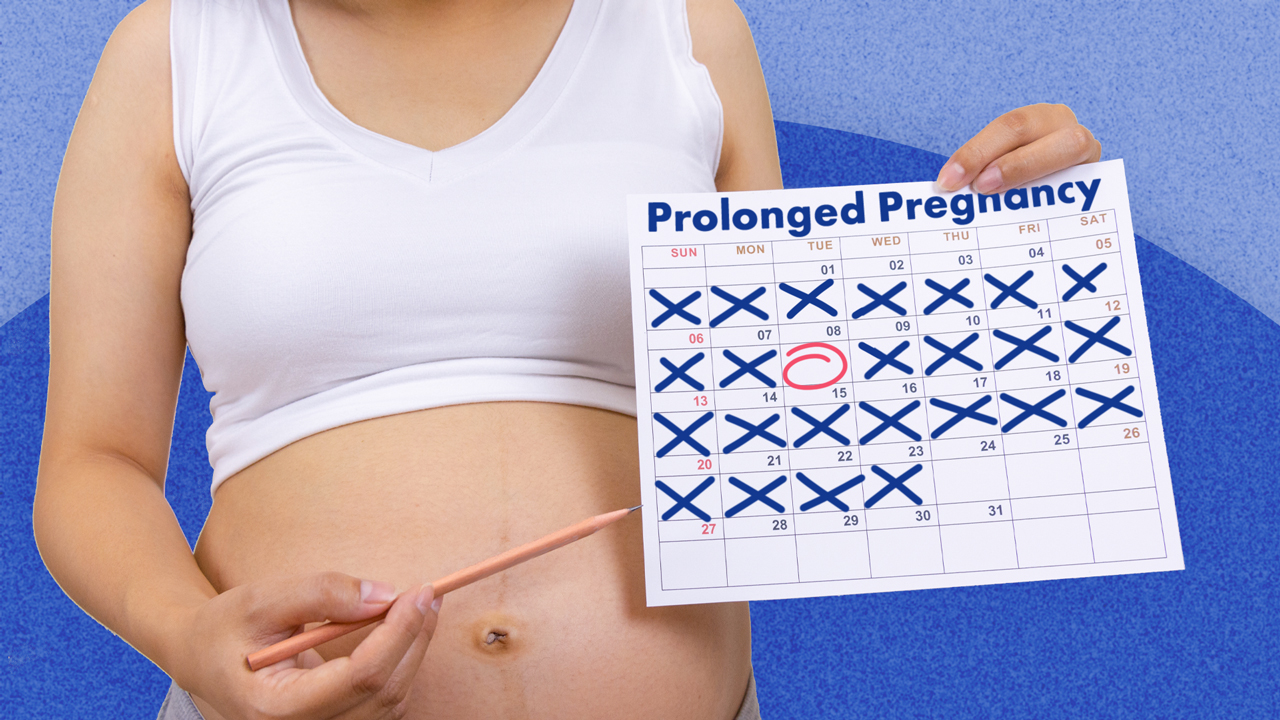What is Prolonged Pregnancy?
Prolonged pregnancy is a pregnancy that extends to 42 weeks of gestation or beyond (DoHaAC 2022).
In Australia, it’s estimated that about 4 per 1,000 babies are born post-term (Pregnancy, Birth and Baby 2022).
Accurate Pregnancy Dating
The estimated date of confinement (EDC) (estimated due date) for a pregancy is typically calculated using first day of the patient’s last menstrual period and their typical menstrual cycle duration (Pregnancy, Birth and Baby 2021).
For patients with irregular menstrual cycles, the EDC might be difficult to calculate. Other factors that may be taken into consideration include:
- Ultrasound examination
- The size of the uterus as estimated by vaginal or abdominal examination
- The time when fetal movements are first experienced.
(Better Health Channel 2014)
Causes of Prolonged Pregnancy
The most common cause of prolonged pregnancy is inaccurate dating based on the patient’s last menstrual period (Norwitz 2022).
In pregnancies that are dated accurately, the cause of prolonged pregnancy is often unknown (Norwitz 2022). However, there are factors that are known to contribute to prolonged pregnancy. These include:
- Obesity
- Nulliparity
- Maternal age over 30
- Male fetal sex
- Previous post-term pregnancy
- Family history of post-term pregnancy.
(Pregnancy, Birth and Baby 2022)

Complications of Prolonged Pregnancy
A key danger of prolonged pregnancy is the increased risk of fetal and neonatal complications.
Mortality
The perinatal mortality rate has been shown to increase post-term. In 2016, the perinatal death rate in Australia was 1.5 per 1,000 births for babies born at 37 to 41 weeks. This increased to 2.2 per 1,000 births after 41 weeks (DoHaAC 2022).
Fetal dysmaturity
About 20% of post-term fetuses are thought to have dysmaturity syndrome, where infants have characteristics resembling chronic intrauterine growth restriction from uteroplacental insufficiency (Caughey 2021). These characteristics include:
- Long, thin arms and legs
- Dry, peeling and parchment-like skin, sometimes with meconium staining
- Loose skin, particularly over thighs and buttocks
- Longer or thicker scalp hair
- Long fingernails and toenails
- A ‘wide-eyed’ appearance
- High level of alertness.
Large body size
As a post-term fetus has continued to grow beyond the EDC, they are at increased risk of complications related to larger body size and macrosomia (weighing more than 4500 grams). These complications can include:
- Prolonged labour
- Problems passing through the birth canal
- Birth trauma such as fractured bones or nerve injury caused by shoulder dystocia (difficulty delivering the shoulders).
(Norwitz 2022)
Meconium aspiration
Post-term fetuses are more likely to pass meconium into the amniotic fluid. This stained fluid can then be inhaled by the fetus, causing breathing difficulties (Norwitz 2022).
Other fetal risks
- Umbilical cord compression from oligohydramnios
- Short-term neonatal complications such as hypoglycaemia, seizures, and respiratory insufficiency.
(Caughey 2021)
Maternal risks
- Difficult labour
- Severe perineal injury
- Increased rate of cesarean birth
- Anxiety and frustration
- Maternal morbidity
- Chorioamnionitis
- Postpartum haemorrhage
- Endomyometritis.
(Norwitz 2022; Caughey 2021)

Management of Prolonged Pregnancy
Management might include:
- Antenatal fetal monitoring to assess the health of the fetus and whether the pregnancy is safe to contiue. This is typically commenced at or after 41 weeks gestation.
- Nonstress testing, which involves measuring fetal heart rate via ultrasound.
- Biophysical profile (BPP) score to assess fetal health.
- Induction of labour - this will typically be performed if spontaneous labour hasn’t commenced by 41 to 42 weeks gestation.
- Sweeping the membranes
- Caesarean birth, particularly if the fetus is exceptionally large.
(Norwitz 2022; DoHaAC 2022)
Patient Education
When a patient is nearing prolonged pregnancy, it’s important to have a discussion with them, explaining the risks and benefits of different management options and establishing their preferences.
You should discuss the following:
- The likelihood of prolonged pregnancy (explaining that most people go into spontaneous labour before 42 weeks)
- Interventions such as membrane sweeping may be offered because pregnancies beyond 42 weeks gestation are associated with a variety of risks
- After 41 weeks, increased fetal monitoring will be required
- The patient should contact a healthcare professional as soon as possible if they notice changes in fetal movements (e.g. decrease, absence or unusual increase).
(DoHaAC 2022)
It’s important to take a holistic approach to this discussion, taking into consideration factors such as logistics (e.g. has the patient travelled to give birth) and the need for community supports (e.g. financial assistance) (DoHaAC 2022).
Topics
References
- Better Health Channel 2014, Baby Due Date, Victoria State Government, viewed 2 June 2023, https://www.betterhealth.vic.gov.au/health/healthyliving/baby-due-date
- Caughey, AB 2021, Postterm Pregnancy, Medscape, viewed 1 June 2023, https://emedicine.medscape.com/article/261369-overview
- Department of Health and Aged Care 2022, Pregnancy Care Guidelines: Prolonged Pregnancy, Australian Government, viewed 1 June 2023, https://www.health.gov.au/resources/pregnancy-care-guidelines/part-j-clinical-assessments-in-late-pregnancy/prolonged-pregnancy
- Norwitz, ER 2022, Patient Education: Postterm Pregnancy (Beyond the Basics), UpToDate, viewed 1 June 2023, https://www.uptodate.com/contents/postterm-pregnancy-beyond-the-basics
- Pregnancy, Birth and Baby 2021, Due Date Calculator, Australian Government, viewed 2 June 2023, https://www.pregnancybirthbaby.org.au/due-date-calculator
- Pregnancy, Birth and Baby 2022, Overdue, Australian Government, viewed 1 June 2023, https://www.pregnancybirthbaby.org.au/overdue
 New
New 
